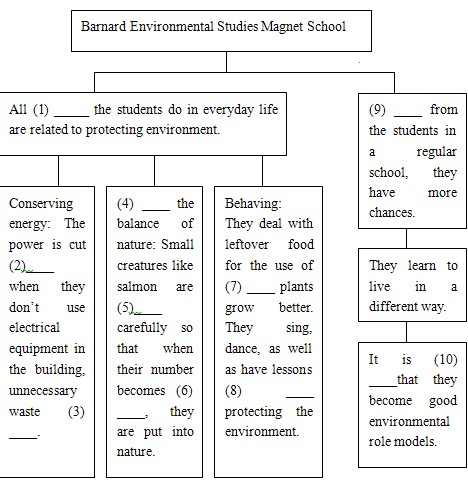阅读理解。
请认真阅读下列短文,并根据所读内容在文章后表格中的空格里填入最恰当的单词。注意:每空格
1个单词。
Do you raise salmon (鲑鱼) in your classroom at school? Do you ever have class while floating down a
river in a canoe? Do you ever throw your school lunch leftovers into a compost (混合肥料) bin when you
are finished? They are all part of a regular school day at Barnard Environmental Studies Magnet School in
New Haven, Connecticut. Known as a "green" school, Barnard attracts students from all over the region who
are interested in environmental studies.
"We do Earth Day all the year round," said Marjorie Drucker, Barnard's Magnet Resource teacher. With
the school's special classes, its 325 students study the environment all day long. "Being green means that
everything in the building is designed with the environment in mind," Drucker told Scholastic News. For
example, the lights go off when people leave the room, and special windows provide "passive light", cutting
down on the need for electric lighting. When a window is open, the air-conditioning automatically turns off.
Conserving energy is not all that students do to help the environment. While learning about the dying
salmon population in the Connecticut rivers, students also do something to help out-they raise more salmon.
In the classrooms there are fish tanks containing salmon eggs. The eggs are kept in water at two degrees
Celsius. After the eggs hatch, students observe the baby salmon through all the stages of development, and
then release the adult salmon into Connecticut rivers.
Composting is another part of taking care of the environment at Barnard Students deal with their lunches
by throwing the remaining food into a compost bin in a greenhouse. The compost is used to help grow plants.
At Barnard, almost everything has to do with the environment. Students sing songs about the environment;
their artworks have something to do with the environment; even their math classes are focused on protecting
the environment.
Barnard offers chances that students can't get in a regular school. The school's goal is to teach children to
be good environmental role models. They also learn to live in a different way. To attend the school, students
have to apply and express their interest in protecting the environment. "Students come here because they care
about the environment," said Drucker.
